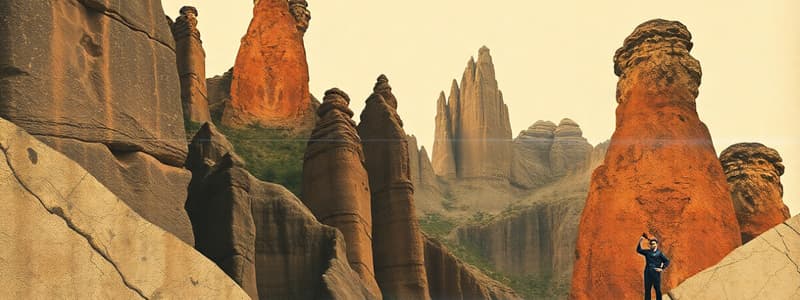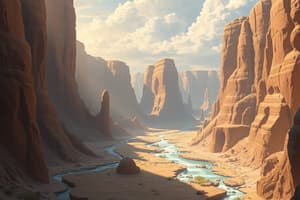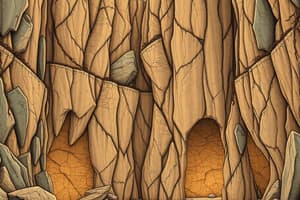Podcast
Questions and Answers
What primary process contributed to the lithification of the carbonate mud and quartz sand into limestone clasts in quartz sandstone?
What primary process contributed to the lithification of the carbonate mud and quartz sand into limestone clasts in quartz sandstone?
- Crystallization of minerals
- Expansion and relaxation of sediments
- Compaction and cementation (correct)
- Evaporation of water content
Which event is suggested to have caused the sediment disturbance that incorporated mud-chip clasts into the rock?
Which event is suggested to have caused the sediment disturbance that incorporated mud-chip clasts into the rock?
- Rapid freeze and thaw cycles
- Earthquake activity
- Hurricane storm (correct)
- Tsunami occurrence
What characteristic of the sediment indicated that the carbonate mud was laid down in a specific environment?
What characteristic of the sediment indicated that the carbonate mud was laid down in a specific environment?
- Very fine grain size (correct)
- Formation in turbulent waters
- Presence of coarse granite particles
- High levels of organic material
What does the rock's arrangement of materials help to convey?
What does the rock's arrangement of materials help to convey?
What does the study of Historical Geology primarily focus on?
What does the study of Historical Geology primarily focus on?
What is the primary reason for the color change from black to red seen in the strata from Inuyama, Japan?
What is the primary reason for the color change from black to red seen in the strata from Inuyama, Japan?
Based on the information presented, which of the following statements accurately describes the relationship between the end-Permian mass extinction and the black to red color change in the Inuyama strata?
Based on the information presented, which of the following statements accurately describes the relationship between the end-Permian mass extinction and the black to red color change in the Inuyama strata?
What is the key insight gained from the observation of the sedimentary sequence in Chilean Patagonia, where mud-rich strata are overlain by sand-rich strata?
What is the key insight gained from the observation of the sedimentary sequence in Chilean Patagonia, where mud-rich strata are overlain by sand-rich strata?
What is the significance of the idea that "the layers get younger to the right" in the description of the Inuyama strata?
What is the significance of the idea that "the layers get younger to the right" in the description of the Inuyama strata?
What is the most important implication of the power of understanding historical geology, as presented in the text?
What is the most important implication of the power of understanding historical geology, as presented in the text?
Which of the following statements accurately reflects the connection between the Giant's Causeway and the Paleocene-Eocene Thermal Maximum (PETM)?
Which of the following statements accurately reflects the connection between the Giant's Causeway and the Paleocene-Eocene Thermal Maximum (PETM)?
Which of the following statements best summarizes the analogy used in the text between fossils in sedimentary rocks and words in a text?
Which of the following statements best summarizes the analogy used in the text between fossils in sedimentary rocks and words in a text?
Based on information presented in the text, which of the following statements is most accurate regarding the relationship between fossils and the study of Earth's history?
Based on information presented in the text, which of the following statements is most accurate regarding the relationship between fossils and the study of Earth's history?
The text states that certain fossils are particularly useful for constraining the age'' and place'' of formation of their host strata. What is the reasoning behind this?
The text states that certain fossils are particularly useful for constraining the age'' and place'' of formation of their host strata. What is the reasoning behind this?
What makes the study of igneous rocks important in understanding Earth's history?
What makes the study of igneous rocks important in understanding Earth's history?
Flashcards
Historical Geology
Historical Geology
The study of Earth's history through analyzing rocks and their features.
Lithification
Lithification
The process of transforming loose sediment into solid rock through compaction and cementation.
Rock Features
Rock Features
Features within rocks that provide clues about their formation and past events.
Limestone
Limestone
Signup and view all the flashcards
Rock Fragmentation
Rock Fragmentation
Signup and view all the flashcards
How do sedimentary layers tell a story?
How do sedimentary layers tell a story?
Signup and view all the flashcards
How do sedimentary rocks record time?
How do sedimentary rocks record time?
Signup and view all the flashcards
What do different sediment types indicate?
What do different sediment types indicate?
Signup and view all the flashcards
What is Historical Geology?
What is Historical Geology?
Signup and view all the flashcards
What is a mass extinction?
What is a mass extinction?
Signup and view all the flashcards
Fossils as language
Fossils as language
Signup and view all the flashcards
Anachronistic Fossils
Anachronistic Fossils
Signup and view all the flashcards
Giant's Causeway
Giant's Causeway
Signup and view all the flashcards
North Atlantic Igneous Province
North Atlantic Igneous Province
Signup and view all the flashcards
Paleocene-Eocene Thermal Maximum
Paleocene-Eocene Thermal Maximum
Signup and view all the flashcards
Study Notes
Historical Geology: Deciphering Earth's Story
- Historical Geology is the study of Earth's autobiography, written in rock formations.
- By understanding the language of rock, called "speaking Rock," we can uncover various process and events of the geological past.
- Studying rock formations allows us to understand the past processes and circumstances that shaped their formation.
- A cobble, for example, can be examined to decipher its history.
Decoding Rock: A Cobble's Story
- A cobble can reveal information about past processes and conditions.
- A smooth tan material, limestone, formed as inorganic carbonate mud in calm water, evidenced by its fine grains.
- It was violently ripped apart and embedded in quartz sand.
Decoding Rock Cont. (Events)
- The energetic event that broke the limestone, likely a storm or hurricane, transported coarse sand particles.
- The sediment became buried, and the chunks of limestone along with quartz sand lithified into rock.
- Fractures developed, later healed by mineral quartz precipitation, indicating deep underground stress and uplift.
- Differential weathering eventually etched the limestone more than the quartz sandstone, creating a distinctive texture.
Sequences of Strata: Layers of the Past
- Studying sedimentary layers (strata), from outcrop, gives a record of past depositional conditions.
- These layers show changes in depositional conditions over time (i.e., shifts from mud to sand).
- Differences in the layers reveal changing conditions, possibly due to a change in water depth, tectonic drift, or mountain building.
Hypothesizing and Testing
- Creating explanations (hypotheses) for observations in layered rock is key in Historical Geology.
- Finding evidence confirming or refuting hypotheses, like mud chips in sand, graded beds in submarine fans, or fossil fauna changes, is critical.
Stories in the Strata: Examples
- In Chilean Patagonia, a strata sequence records a shift from muddy to sandy deposition, potentially linked to changes in water depth or tectonic activity.
- In Inuyama, Japan, rotated strata reveal a transition from low to high deep-ocean oxygen, potentially linked to the end-Permian mass extinction.
Fossils: Time Markers
- Fossils are unique "words" that mark specific times or places of rock formation.
- Used as clues to the age and place of formation in strata.
- A significant time or place is marked by specific fossils (e.g., pachycephalosaurs, trilobites, ichthyosaurs).
- The presence of specific fossils in strata limits the possible timescales of formation, like a digital time stamp.
Beyond Sedimentary: Other Rock Types
- Igneous rocks, formed from cooled lava, provide insights into volcanic activity, like the Giant's Causeway.
Metamorphic Rocks: Deep Earth Journeys
- Metamorphic rocks, like blueschist, formed from transformations at great depths within the Earth.
- The minerals in blueschist reveal a significant journey, from Earth's surface to deep within the mantle, exhibiting pressure and chemical changes.
Tectonic Structures: Scars on Earth
- Tectonic structures, like folds, faults, and shear zones, also tell stories about Earth's history.
- The orientation, deformation, and elevation of these structures can reveal Earth's past events.
Earth's Story, Our Story
- Our bodies are made of recycled Earth atoms, showing a deep connection between us and the planet.
- The Earth also provides processes for life that make life on Earth possible, from metallic cores and oceans to volcanoes and comets.
- Our ability to "speak Rock" helps us understand our existence and the future.
Importance of Historical Geology
- Understanding Historical Geology is essential for understanding the Earth’s past and developing solutions for the future.
- The study of rock allows us to address broader questions like climate and life.
Studying That Suits You
Use AI to generate personalized quizzes and flashcards to suit your learning preferences.




